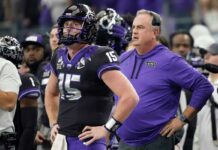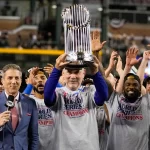On a day for fathers everywhere, Jordan Spieth showed us all up by giving his old man quite a gift – a U.S. Open Championship Trophy. The USGA hosted their Open for the 115th time and for the first time ever in the Pacific Northwest, and if all the courses in that part of the world are similar to Chambers Bay, hopefully it will be the last one too.

The tournament saw a little bit of everything, including another disastrous performance by Tiger Woods, Aussie Jason Day battling vertigo throughout, freight trains running by greens and fairways and a brutal 3-putt on the final hole by Dustin Johnson to hand the Open to Spieth – who initially looked more shocked than excited after watching Johnson crumble at the worst time possible.

As for Chambers (of Horrors) Bay, everyone will have an opinion on the course, but to me the USGA missed point on this one. The Open is always played on a tough track, but at times this course looked more like a strip mining field than a country club golf course.
There were markers to show where the fairways ended and the greens began (and I use the terms “greens” very loosely here), because otherwise there is no differentiation between the two. Round, white sprinkler heads are littered throughout the course, and when the flags are removed from the holes it’s difficult to differentiate the watering devices from the actual cups.

At times it reminded me of a course that would have been designed for the video game Golden Tee – with undulations on many of the greens so ridiculous it simply rendered putts impossible to make, and fairway shots were rolling 20-30 yards from center placement into sand traps on seemingly every hole.
On the 14th green Brent Snedeker lined up a par putt after completing a furious run of birdies to get himself back into contention, but the ball hit some sort of “bump,” redirecting it to the left where it proceeded to miss the cup by about four feet and roll back down past him and to his left. Commentator Brad Faxon said, “I’ve never seen anything like that on a green before,” and that it “looked like it hit a stake in the ground.”
But Spieth survived the course when others couldn’t, and rebounded from a double bogey on the par-three 17th hole to birdie the 18th, finishing with a four day score of -5. He had the crowd solidly behind him with chants of USA USA breaking out at times, all hoping an American would claim this country’s Open Championship (international players had won eight of the previous eleven U.S. Opens). Spieth also had fan support for his caddy Michale Grellar, a local who used to ply his craft on this very course – and undoubtedly had some knowledge that proved useful to Spieth throughout.
Spieth at 21 is now the youngest to win two career majors since Gene Sarazan did it in 1922 at age 20. He’s also the youngest U.S. Open champion since Bobby Jones captured the title in 1923 (when just a few months younger than Spieth), and only the 6th player to win the Open in the same year as the Masters (others are Tiger Woods in 2002, Jack Nicklaus in 1972, Arnold Palmer in 1960, Ben Hogan in 1951 & ‘53, and Craig Wood in in 1941). To say Spieth is now being mentioned in rarefied air would be an accurate assessment.
When questioned about being halfway to the PGA’s version of a Grand Slam (with the British Open and the PGA still to play), the Dallas native simply said, “You can’t win them all unless you win the first two.” Who says wisdom only comes with age?









